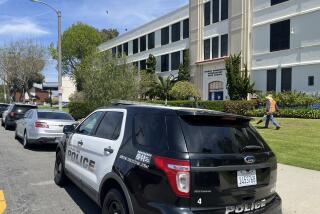L.A. officials target crime near 20 schools
Los Angeles leaders unveiled several initiatives Wednesday to reduce crime at and around 20 public schools, including a computerized tracking system that authorities have already used to tailor violence-fighting strategies to the specific conditions in hot spots around the city.
The anti-crime plan also calls for rookie police officers and their supervisors to mentor students at the schools -- in South Los Angeles, on the Eastside and in the San Fernando Valley -- starting next month. And it envisions greater community involvement, enlisting adults to walk with groups of children who must pass through some of the city’s most dangerous neighborhoods en route to classes.
“No child should ever have to risk getting hurt on their path to a diploma,” Mayor Antonio Villaraigosa told a news conference at Irving Middle School in Glassell Park, where he was joined by Police Chief William J. Bratton, schools Supt. David L. Brewer and several other local officials.
Police began using crime data to help communities reduce violence around Fremont and Crenshaw high schools last year, although the authorities could not say whether that effort had produced results.
One parent featured with Villaraigosa and the other officials Wednesday voiced skepticism about the latest crime-reduction program.
“We need safer schools. We need safer streets,” said Myrian Magana, 50, whose daughter attended Irving Middle School. “Please hope this is not just a dream or just talk.”
The 20 middle schools and high schools are in so-called gang reduction zones. Those zones are already the focus of an effort that includes an intensified police presence and a mix of economic development programs, social services, job placement counseling and gang intervention groups.
Besides Irving, the campuses include Dorsey, Jefferson, Jordan and Roosevelt high schools, and Hollenbeck, Markham, Pacoima, Stevenson and Nightingale middle schools, among others.
At the heart of the new effort is CompStat, a computerized tracking system that maps crime and allows police to deploy officers to address trouble areas. Bratton and others credit the system with playing a role in the city’s dropping crime rate.
Bratton did not say how many officers or other resources would be deployed to schools based on the new crime data. But he said the Police Department would coordinate its response with the Los Angeles school police and other departments that patrol areas served by the Los Angeles Unified School District, including the Gardena police.
“We all have limited resources, but what we always attempt to do is reprioritize and refocus . . . to tell us where we can get the biggest bang for the buck,” Bratton said.
--
More to Read
Sign up for Essential California
The most important California stories and recommendations in your inbox every morning.
You may occasionally receive promotional content from the Los Angeles Times.










